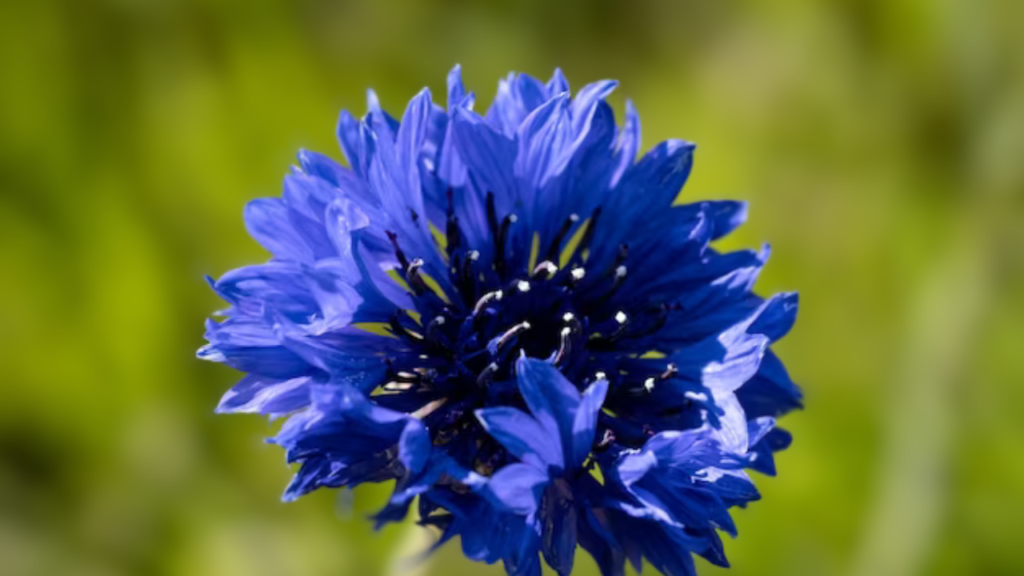Introduction: Blue cornflower, scientifically known as Centaurea cyanus, is a charming, flower that has captured the hearts of gardeners, herbalists, and flower enthusiasts alike. With its striking blue hue and rich cultural history, the blue cornflower holds a special place in the world of flora. In this comprehensive guide, we will delve into the world of its exploring cultivation, uses, and numerous benefits.
Cultivation of Blue Cornflower
These are relatively easy to grow, making them an attractive option for both novice and experienced gardeners. These stunning annuals thrive in well-drained soil and prefer full sun, making them an excellent choice for garden borders, wildflower meadows, and cottage gardens. When planting blue cornflowers, it’s essential to ensure adequate spacing to allow for proper air circulation and prevent overcrowding.
Proper soil preparation: When it comes to soil, blue cornflowers prefer moderately fertile, loamy soil with a neutral slightly alkaline pH. Proper soil preparation, including amending the soil with organic matter, can significantly enhance the growth and vigor of it. Regular watering, particularly during dry spells, is crucial for healthy plants and abundant flowering.
Also read: how to preserve rose petals for lasting beauty
As for propagation: it can be grown from seed, which can be sown directly into the garden in the early spring or late fall. For optimal results, it’s recommended to lightly press the seeds into the soil and keep them consistently moist until germination. Additionally, deadheading spent flowers can prolong the blooming period and encourage continuous flower production.


Uses of Blue Cornflower: Beyond its ornamental value, it boasts a rich history of medicinal and culinary uses. Traditionally, the petals of the it has been utilized in herbal teas and infusions, for their mild, floral flavor and potential health benefits. The vibrant blue petals can also be used as a natural dye, adding a touch of color to culinary creations and artisan crafts.
In addition to its culinary and decorative uses, it extract is a sought-after ingredient in the beauty and cosmetic industry. Its soothing and antioxidant properties make it a popular addition to skincare products, including creams, lotions, and serums.
Furthermore, the blue flower holds symbolic significance in various cultures, often representing romance, prosperity, and rejuvenation. Its timeless appeal has led to its inclusion in floral arrangements, wedding bouquets, and decorative arts.
Benefits of Blue Cornflower
it offers a plethora of benefits, extending beyond its visual allure. From a medicinal standpoint, the petals it contain compounds that are believed to possess anti-inflammatory and soothing properties, making them a valuable addition to herbal remedies and natural products.
the realm of biodiversity: blue cornflowers play a role in supporting pollinators and attracting bees, butterflies, and other beneficial insects to the garden. Their nectar-rich blooms serve as a food source for these essential pollinators, contributing to the health and vitality of local ecosystems.
A holistic perspective: the presence of it in the garden can provide a sense of tranquility and natural beauty, creating a serene and rejuvenation. Whether enjoyed in the garden, as part of floral arrangements, or incorporated into various aspects of daily life, the presence of blue cornflowers can infuse joy and natural elegance.
incorporating valuable: information about it, its cultivation, uses, and benefits, this content can position itself as a comprehensive resource for individuals seeking knowledge about this captivating flower.
Cultivation of Blue Cornflower:
Sowing and Planting: these are relatively easy to grow, making them an attractive option for both novice and experienced gardeners. Sowing seeds directly into the garden in early spring or late fall is a common practice. It’s essential to lightly press the seeds into well-drained soil and keep them consistently moist until germination. For optimal growth, it thrives in full sun and moderately fertile, loamy soil with a neutral slightly alkaline pH.
Soil Preparation and Maintenance: Before planting, it’s beneficial to prepare the soil by amending it with organic matter. Ensuring adequate spacing between plants allows for proper air circulation and prevents overcrowding. Regular watering, particularly during dry spells, is crucial for healthy plant development.
Care and Maintenance: Regular deadheading of spent flowers can prolong the blooming period and encourage continuous flower production. Additionally, mulching around the base of the plants helps retain soil moisture and suppress weed growth.
Culinary and Decorative Uses: The vibrant blue petals of it have historically been used in herbal teas and infusions, adding a mild, floral flavor and potential health benefits. Furthermore, the petals can be used as a natural dye, adding a touch of color to culinary creations and artisan crafts. Symbolically, these are often included in floral arrangements, wedding bouquets, and decorative arts.
Medicinal and Cosmetic Applications: it has been traditionally used for its medicinal properties, with the petals containing compounds believed to possess anti-inflammatory and soothing properties. In addition, extract is a sought-after ingredient in the beauty and cosmetic industry, due to its soothing and antioxidant properties found within skincare products.
Biodiversity and Ecosystem Support: it plays a crucial role in supporting biodiversity, attracting essential pollinators such as bees, butterflies, and other beneficial insects to the garden. Their nectar-rich blooms serve as a food source for these pollinators, contributing to the health and vitality of local ecosystems.
Symbolic and Aesthetic Value: Beyond their utility, they hold symbolic significance in various cultures, often representing romance, prosperity, and rejuvenation. Their timeless appeal and aesthetic charm make them a cherished addition to gardens and floral arrangements, infusing spaces with natural elegance and tranquility.This extended content provides a detailed exploration of it, encompassing cultivation guidelines, diverse uses, and the ecological and aesthetic value it offers.
Additional Information on Uses of Blue Cornflowers:
Symbolic Significance in Various Cultures: it holds symbolic significance in various cultures, often representing romance, prosperity, and rejuvenation. In folklore and traditions, it has been associated with love and fidelity. Its timeless appeal and aesthetic charm make it a cherished addition to floral arrangements and decorative arts, creating a serene and rejuvenating atmosphere.
Relaxing Aroma and Herbal Infusions: The petals of blue cornflowers release a subtle, relaxing aroma, making them a delightful addition to herbal infusions and potpourri. Their mild, floral flavor is often utilized in teas, adding a touch of elegance and a soothing aspect to the beverage. Additionality petals are often used to adorn pastries, imparting a delicate and visually appealing touch to culinary creations.
By incorporating these details, the content provides a comprehensive overview of it, encompassing cultivation guidelines, diverse uses, and the ecological, aesthetic, and cultural value it brings.
it stands as a testament to the captivating beauty and multifaceted utility of the natural world. Through their enchanting blossoms, cultural significance, and diverse applications, it continue to enthrall and inspire individuals across the globe. By exploring the cultivation, uses, and benefits of it, we gain a deeper appreciation for these remarkable blooms and the abundant gifts they offer to humanity and the environment.

